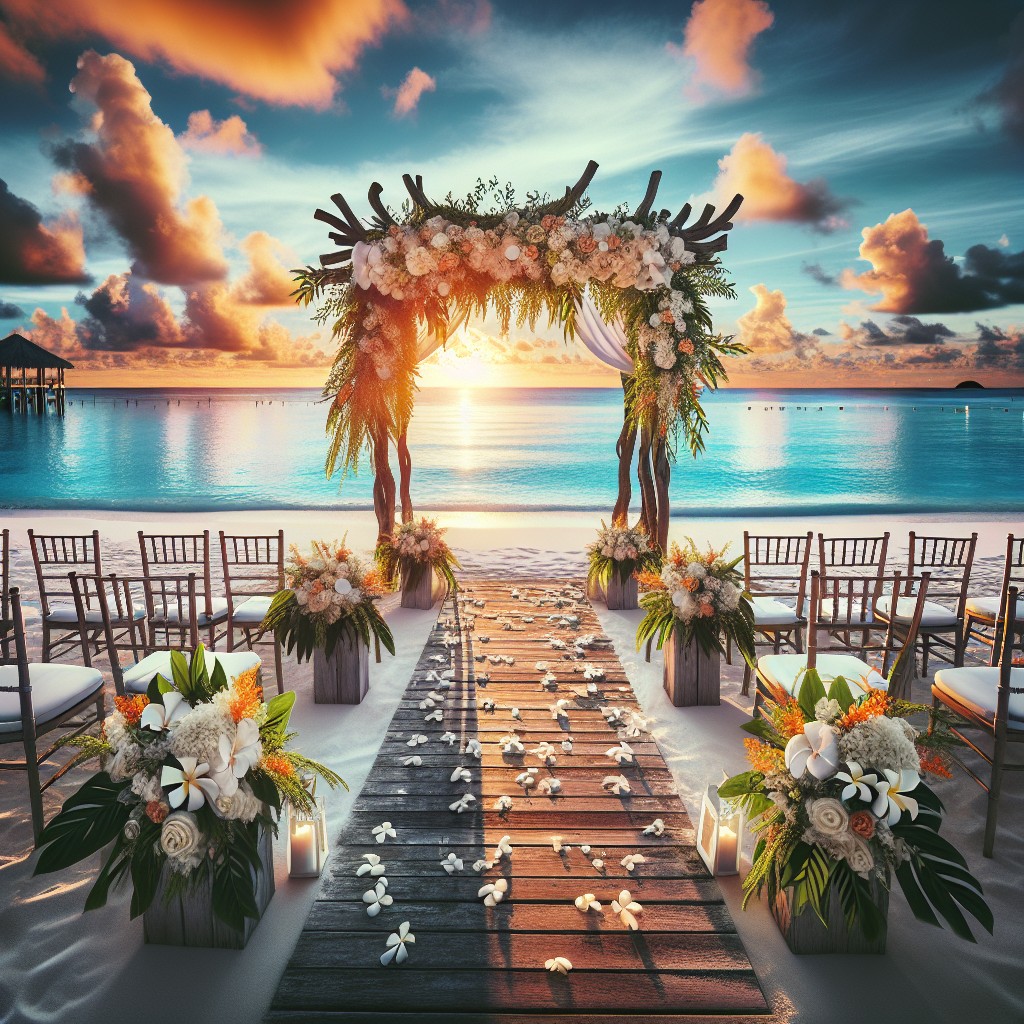Discover the essentials of beach wedding attire to ensure comfort and style for your seaside ceremony.
Key takeaways:
- Embrace light, breathable fabrics.
- Opt for light colors.
- Choose attire that is casual yet formal.
- Consider the sand and terrain when selecting footwear.
- Accessorize thoughtfully with sun hats, sunglasses, and sunscreen.
Key Takeaways On Beach Wedding Attire
Embrace light, breathable fabrics to stay comfortable in the beach climate.
Opt for light colors to reflect the sun’s rays rather than absorb them.
Choose attire that strikes a balance between casual and formal—the setting is relaxed, but the occasion is significant.
Consider the sand and terrain when selecting footwear; think about espadrilles, sandals, or even going barefoot.
Accessorize thoughtfully with sun hats, sunglasses, and sunscreen for daytime ceremonies to protect against the sun’s glare.
Bear in mind the potential for wind—avoid overly loose garments and secure any flowing dresses or accessories.
Stay true to the wedding’s theme and dress code if specified, while also considering the venue’s natural elements in your attire choices.
What Is a Beach Wedding?

A beach wedding is a ceremony held by the shore, typically casual or semi-formal. The scenic backdrop of the ocean creates a romantic ambiance. Sand underfoot, the sound of waves, and the possibility of a sunset or sunrise view define the allure of such nuptials.
This setting often influences attire, decor, and the event’s overall tone, prioritizing comfort and harmony with the natural surroundings. Adapting to the elements, like wind and sand, also shapes the practical aspects of planning a beach wedding.
What Are the Dos and Don’ts of Beach Wedding Attire?
When selecting your outfit for a beach wedding, consider functionality and style that complement the seaside setting:
Dos:
- Opt for Lightweight Fabrics: Breezy materials like linen, chiffon, or cotton keep you cool under the sun.
- Wear Flat or Wedge Shoes: Sand doesn’t accommodate heels well—choose sandals or wedges that won’t sink.
- Choose Light Colors: Pastels or light hues work well with the natural backdrop, instead of overpowering it.
- Consider a Hat or Sunglasses: Protect your eyes and skin while adding a chic touch to your beach ensemble.
- Go for Casual Elegance: Balance elegance with comfort; a maxi dress or a light-colored linen suit strikes the right tone.
Don’ts:
- Avoid Heavy Gowns and Suits: Thick fabrics and layered dresses are impractical for the beach environment.
- Skip the Stilettos: High heels and sandy beaches don’t mix; they are impractical and uncomfortable.
- Steer Clear of Dark Colors: Dark attire absorbs heat and can feel out of place against the light and airy beach setting.
- Forget Sun Protection: Going without sunscreen or protective accessories can lead to sunburn.
- Overdress: A full tuxedo or ball gown is usually too formal for the laid-back beach vibe.
By following these guidelines, you’ll ensure comfort without compromising on elegance.
What Are Some Appropriate Outfit Ideas for a Beach Wedding?
Selecting the right outfit for a beach wedding hinges on combining elegance with comfort, considering the unique environment of sand, sun, and sea breeze.
For women, flowy maxi dresses made from breathable materials like chiffon or cotton keep things both chic and comfortable. Soft pastel colors or tropical prints align with the setting and keep the tone festive. For footwear, espadrilles or embellished sandals are preferable over high heels which can sink into the sand.
Men can opt for linen or lightweight cotton suits which are cooler than traditional wool. A light-colored palette such as beige, light grey, or a soft pastel keeps the attire wedding-appropriate yet beach casual. Footwear can consist of loafers or boat shoes, which can be worn without socks.
As for accessories, both genders should consider sun protection. Fashionable sunglasses or a wide-brimmed hat can look tasteful while shielding from the sun. Jewelry should be minimal to not outshine the setting; think simple pendants, bracelets, and stud earrings.
Children’s attire typically mirrors adult fashion but with an emphasis on comfort and freedom of movement. Little girls might wear sundresses and boys can don short-sleeve shirts with light trousers or shorts.
Overall, the aim is to look purposefully put together without seeming out of place against the natural, casual backdrop of a beach setting.
Beach Wedding Attire Etiquette
Understanding the nuances of etiquette when selecting your ensemble for a beach wedding ensures both comfort and appropriateness. Let’s break it down:
- Dress Code Clarity: Check the invitation for any specific dress code guidance. “Beach formal” or “beach chic” are common indicators of the expected attire.
- Fabric Choice: Opt for breathable, lightweight fabrics like linen, chiffon, or cotton that will help you stay cool in the sun and sand.
- Color Consideration: Pastels, neutrals, and other soft colors tend to complement the natural beach backdrop, while avoiding white is respectful to the bride.
- Footwear Functionality: Sand-friendly shoes, such as sandals or wedges, make navigating the terrain easier than heels.
- Sun Protection: Sun hats and sunglasses protect you from the elements and tie your outfit together fashionably.
- Accessory Awareness: Keep accessories minimal to prevent them from overpowering your look or being cumbersome in the beach breeze.
Respecting these etiquette tips will contribute to a harmonious and memorable beach wedding experience for everyone involved.
Keep reading:





